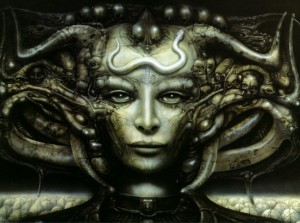 You never know where the fantastic in pop culture will surface, and where religion and the fantastic will intersect. I have been doing some research lately for a couple of essays on Neopaganism I need to write for a book on world religions. Today I looked at Magic and Witchcraft by Nevil Drury (Thomas & Hudson, 2003), and in his chapter on “Technopagans and Digital Magicians” there was an interesting reference to the artist H. R. Giger, perhaps best known for his creation of the alien in the series of Alien films which first appeared thirty years ago. Under the subheading of “Dark Archetypes” Drury writes of Giger:
You never know where the fantastic in pop culture will surface, and where religion and the fantastic will intersect. I have been doing some research lately for a couple of essays on Neopaganism I need to write for a book on world religions. Today I looked at Magic and Witchcraft by Nevil Drury (Thomas & Hudson, 2003), and in his chapter on “Technopagans and Digital Magicians” there was an interesting reference to the artist H. R. Giger, perhaps best known for his creation of the alien in the series of Alien films which first appeared thirty years ago. Under the subheading of “Dark Archetypes” Drury writes of Giger:
While many Neopagan responses to cyberspace are innovative and essentially positive, there is an underbelly – a darker realm which feeds on fear and powerlessness in a rapidly changing world. One of the archetypes that embodies these feelings most strongly is that of the Alien – the space-entity created by H. R. Giger, which featured in the Oscar-winning film of the same name and which has since become an icon of the cyberculture.
Drury continues:
Many of Giger’s most surreal artworks are now on permanent display at his museum in Castle St. Germain in Gruyeres, Switzerland, which opened in June 1998. The paintings draw strongly on the left-hand path of Western magic as well as on fantasy and horror fictions, as in his extraordinary The Necronomicon of 1978. There is an unquestionable potency – even a macabre beauty – in his biomechanoid creations, but his nightmare fusions of the human and mechanical also breathe a sense of no escape– a sense that we are all trapped in a virtual hell of our own making. Perhaps this is a portent of our times. …There is no doubt that, in terms of his art, Giger is a magician – conjuring dramatic visions that propel us into the darker recesses of the psyche.
But while placing Giger in the category of techno and digital magician, Drury clarifies his interpretation of Giger and his work in this context:
While he has studied the works of Aleister Crowley, like many other cyberspace enthusiasts, eh is not a magician in the conventional sense. He does not perform rituals, engage in invocations, or summon spirits. But one could hardly find a better temple of the black arts than the Spell Room at the H. R. Giger Museum, where the walls display several of his most powerful paintings and murals. It would seem that, when the thin veil across Giger’s psyche is slightly drawn aside, tempestuous visions of evil and alienation come forth. It is almost as if the dark gods were emerging from his nightmares.
Giger’s work and other material can be found at his website.





There are no responses yet